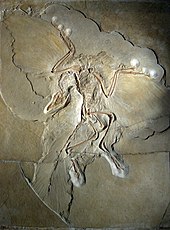
Back حفرية انتقالية Arabic Преходен фосил Bulgarian Fòssil de transició Catalan Overgangsform (fossil) Danish Mosaikform German Transira fosilio Esperanto Forma transicional Spanish فسیل انتقالی Persian Välimuotofossiili Finnish Forme transitionnelle French

| Part of a series on |
| Paleontology |
|---|
 |
|
Paleontology Portal Category |
A transitional fossil is any fossilized remains of a life form that exhibits traits common to both an ancestral group and its derived descendant group.[1] This is especially important where the descendant group is sharply differentiated by gross anatomy and mode of living from the ancestral group. These fossils serve as a reminder that taxonomic divisions are human constructs that have been imposed in hindsight on a continuum of variation. Because of the incompleteness of the fossil record, there is usually no way to know exactly how close a transitional fossil is to the point of divergence. Therefore, it cannot be assumed that transitional fossils are direct ancestors of more recent groups, though they are frequently used as models for such ancestors.[2]
In 1859, when Charles Darwin's On the Origin of Species was first published, the fossil record was poorly known. Darwin described the perceived lack of transitional fossils as "the most obvious and gravest objection which can be urged against my theory," but he explained it by relating it to the extreme imperfection of the geological record.[3] He noted the limited collections available at the time but described the available information as showing patterns that followed from his theory of descent with modification through natural selection.[4] Indeed, Archaeopteryx was discovered just two years later, in 1861, and represents a classic transitional form between earlier, non-avian dinosaurs and birds. Many more transitional fossils have been discovered since then, and there is now abundant evidence of how all classes of vertebrates are related, including many transitional fossils.[5] Specific examples of class-level transitions are: tetrapods and fish, birds and dinosaurs, and mammals and "mammal-like reptiles".
The term "missing link" has been used extensively in popular writings on human evolution to refer to a perceived gap in the hominid evolutionary record. It is most commonly used to refer to any new transitional fossil finds. Scientists, however, do not use the term, as it refers to a pre-evolutionary view of nature.
- ^ Freeman & Herron 2004, p. 816
- ^ Cite error: The named reference
Protherowas invoked but never defined (see the help page). - ^ Darwin 1859, pp. 279–280
- ^ Darwin 1859, pp. 341–343
- ^ Prothero, Donald R. (1 March 2008). "Evolution: What missing link?". New Scientist. 197 (2645): 35–41. doi:10.1016/s0262-4079(08)60548-5. ISSN 0262-4079.